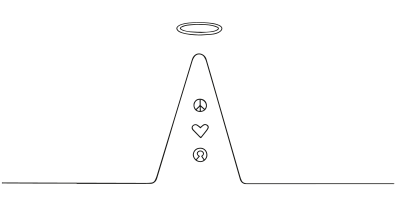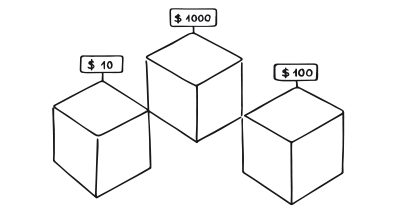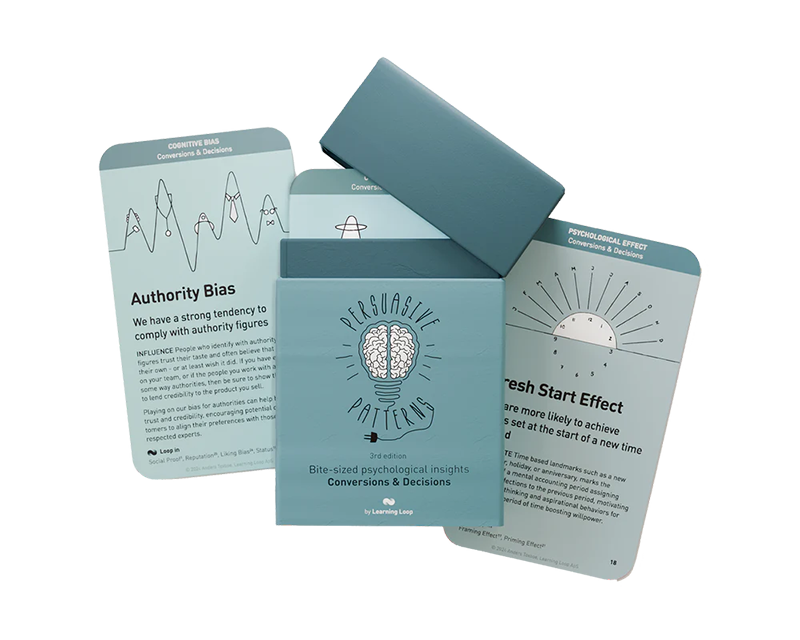Persuasive Patterns: Relation
Noble Edge Effect
Products of socially responsible companies are seen as superior

The Noble Edge Effect describes the tendency of consumers to perceive products and services from socially responsible companies as superior. In simpler terms, people are more likely to choose brands that align with their values and make a positive impact on the world.
Imagine you’re at the grocery store, faced with two similar brands of cereal (Brand A & Brand B). Both offer comparable nutrition and taste. However, Brand A prominently displays a label highlighting its commitment to sourcing sustainable ingredients and supporting local farmers. Research by Carrigan & Attala (2001) suggests you might be more likely to choose Brand A. Knowing the company prioritizes environmental responsibility and community well-being aligns with your own values, potentially tipping the scales in their favor (Carrigan & Attala, 2001).
This effect extends to the digital world as well. Imagine searching for a new fitness app. Two options (App X & App Y) offer similar workout programs and features. However, App X showcases its partnership with a charity that promotes healthy living in underserved communities. Studies by Peloza et al. (2013) indicate that App X might be more appealing. Knowing the app contributes to a social cause resonates with your desire to make a positive impact, potentially influencing your decision (Peloza et al., 2013).
In both scenarios, the Noble Edge Effect is in play. Consumers are increasingly drawn to brands that demonstrate a commitment to social responsibility, leading to more favorable purchase behavior.
The study
One of the foundational studies examining the Noble Edge Effect was conducted by researchers Bhattacharjee, Dana, and Newman (2013). This study explored how corporate social responsibility (CSR) influences consumer perceptions of product effectiveness. The researchers presented participants with two different brands of toothpaste, one from a company known for its strong CSR initiatives and the other from a more profit-driven corporation. The findings revealed that participants perceived the CSR-supportive brand’s toothpaste as more effective in preventing cavities, despite both brands having similar formulations. This study illustrates how a company’s ethical behavior can significantly sway product perceptions, highlighting the practical implications of the Noble Edge Effect in consumer decision-making.
Bhattacharjee, A., Dana, J., & Newman, G. E. (2013). The tainted altruism effect: When doing some good is evaluated as worse than doing no good at all. Psychological Science, 24(3), 1443-1449.
The Noble Edge Effect leverages the positive brand image created by a company’s commitment to social responsibility to enhance its products’ appeal. When a company actively engages in ethical practices, such as environmental sustainability, charitable contributions, or fair trade, it often gains a competitive advantage. Consumers tend to associate the company’s noble deeds with high-quality products or services, believing that a company good to the world must also be good to its customers. This effect not only boosts sales but can also enhance customer loyalty and brand differentiation in a crowded market.
Social Identity Theory, proposed by Tajfel and Turner (1979), lays the groundwork for understanding the Noble Edge Effect. This theory suggests that individuals derive a sense of self from the groups they belong to. Consumers often identify with brands that share their values and social concerns. The Noble Edge Effect leverages this concept by associating a brand’s social responsibility efforts with the consumer’s own identity.
When a brand aligns itself with a social cause a consumer cares about, it becomes part of the consumer’s in-group. This fosters a sense of positive self-perception and a desire to maintain a positive group image. Choosing the socially responsible brand allows the consumer to express their values publicly and reinforce their self-identity.
Furthermore, moral psychology contributes to the Noble Edge Effect. Consumers often judge a company’s moral character based on its actions, such as its commitment to social responsibility. When companies engage in ethical practices, they are seen as morally superior, which in turn influences consumers to view their products as superior. This moral endorsement acts as a heuristic, a mental shortcut, that consumers use to make quicker, favorable decisions about a product, assuming that good ethics correlate with high quality.
The principle of cognitive dissonance also plays a role. This theory suggests that individuals strive for consistency between their beliefs and actions. When consumers believe in the importance of social responsibility, purchasing products from a company known for its ethical practices reduces cognitive dissonance and aligns their actions with their values, thereby providing psychological comfort and satisfaction.
These principles highlight the Noble Edge Effect’s roots in deep-seated human needs for belonging, self-consistency, moral alignment, and identity enhancement. Understanding these underlying psychological drivers helps explain why the Noble Edge Effect can be a powerful tool in consumer persuasion, particularly for ethically conscious consumers.
The Noble Edge Effect is further amplified by the halo effect, a cognitive bias where positive qualities are associated with an entity. When a company is perceived as socially responsible, consumers tend to view its products more favorably, even if those products have no inherent connection to the social cause. However, the strength of this effect hinges on the perceived genuineness of the company’s motives. Consumers are more likely to be influenced by social responsibility when they believe the company’s actions stem from genuine benevolence rather than self-interest.
The Noble Edge Effect highlights the complex interplay between morality, social identity, and consumer behavior. By understanding these psychological factors, companies can leverage social responsibility initiatives to not only create positive societal impact but also gain a competitive edge in the marketplace. However, the key lies in authenticity - consumers can see through performative acts of kindness, and true commitment to social good is what ultimately fosters brand loyalty and drives the Noble Edge Effect.
Designing products with the Noble Edge Effect
The Noble Edge Effect presents a powerful opportunity for brands to connect with a growing segment of socially conscious consumers by embedding ethical practices into the core of your product. This could involve using sustainable materials, fair labor practices, or designing energy-efficient products. These elements become becomelding blocks for a product narrative that resonates with socially conscious consumers.
Transparency is paramount. Provide clear and accessible information about how and why your products are made ethically. This can be achieved through informative product tags, dedicated website sections, or interactive features within the product itself. For instance, a clothing company might use tags explaining material origin, supported by a digital campaign showcasing the positive impact on involved communities.
Integrate your social responsibility efforts into marketing and packaging materials. Use visuals to tell compelling stories that connect consumers emotionally to your ethical practices. This could involve imagery of people and places positively impacted by your initiatives or diagrams illustrating a product’s life cycle and environmental footprint.
For digital products, consider user interface and user experience design that reinforces your commitment to ethics. Features allowing users to customize their experience or choose greener options can be powerful tools. For example, a digital platform could offer options to offset carbon emissions or choose eco-friendly packaging at checkout.
Other examples are:
- Eco-mode options
Digital products can offer users an “eco-mode” that reduces resource consumption by lowering display brightness, optimizing data usage, or automatically putting the device to sleep after a shorter period of inactivity. - Sustainable packaging selection
At checkout, e-commerce platforms could allow customers to choose eco-friendly packaging options made from recycled materials or minimal packaging overall. - Cause-based customization
For certain products, users could be given the option to personalize them with designs or features that support a specific social cause the company champions. - Reward programs for sustainable choices
Implement a points system where users earn rewards for opting for eco-friendly features within the product (e.g., using public transportation in a travel booking app) or participating in sustainability challenges. These points could then be redeemed for discounts or donations to environmental causes. - Customer testimonials and stories
Feature stories and testimonials from customers who appreciate the company’s commitment to social responsibility, creating a sense of community and shared values.
All these practices must be authentic and backed by genuine action. Consumers are increasingly skeptical of greenwashing, so substantiating claims with real evidence and third-party certifications is crucial for maintaining trust and credibility.
Ethical recommendations
The Noble Edge Effect offers a powerful tool for brands to connect with consumers who value social responsibility. However, it’s crucial to acknowledge potential ethical considerations to ensure its use remains positive and user-centric.
The effect can be misused to manipulate consumer behavior. Companies might exploit emotional appeals to ethical concerns without genuinely addressing them. This could involve exaggerating the social impact of their practices or associating themselves with social causes they don’t demonstrably support. Such tactics ultimately erode trust and backfire on brands.
Consumers are increasingly skeptical of unsubstantiated sustainability claims. Avoid making misleading statements about your company’s environmental or social impact. Ensure your social responsibility efforts are demonstrably authentic and backed by concrete actions. Certifications from independent bodies can add credibility.
Don’t fall into the trap of token gestures. Superficial partnerships or one-off charitable donations for PR purposes will be readily seen through by consumers. Focus on building a long-term strategy for ethical practices that are deeply integrated into your core business operations.
Shrouding your social responsibility efforts in secrecy undermines trust. Provide clear and accessible information about your ethical practices. Avoid jargon and use compelling storytelling to connect with consumers on an emotional level. This could involve showcasing the positive impact of your initiatives through engaging visuals or user-friendly data visualizations.
To avoid manipulation, the focus should always be on demonstrably positive social or environmental impact. Companies should prioritize authentic integration of ethical practices into their core operations, not merely use them as a marketing tool. Transparency and clear communication about these efforts are essential for building trust with consumers.
The Noble Edge Effect should not overshadow the core value proposition of a product. Ethical practices should complement and enhance the user experience, not become a substitute for a quality product or service. Companies must ensure that their social responsibility efforts are aligned with user needs and expectations.
While highlighting the positive impact of ethical practices can be persuasive, it’s important to avoid framing this as a means of shaming consumers who choose competing brands. The goal is to encourage positive change through education and empowerment, not social pressure.
To ensure the ethical application of the Noble Edge Effect, several best practices should be followed:
- Authenticity first
Ensure your social responsibility efforts are genuine and backed by verifiable evidence. Focus on long-term commitment to ethical practices, not short-term marketing ploys. Companies should ensure that their socially responsible claims are backed by genuine and significant action. This includes investing in sustainable practices that have a real impact, rather than just making superficial changes for marketing purposes. - Be transparency and accountable
Communicate your social responsibility efforts clearly and accessibly. Use storytelling to connect with consumers on an emotional level, but avoid misleading or exaggerated claims. This involves openly sharing details about the nature of their actions, the outcomes, and even the challenges faced. Providing this level of transparency helps build trust and credibility with consumers. - Get third-party verification
To avoid accusations of greenwashing, companies should seek verification from reputable third-party organizations that can validate their social responsibility claims. This external validation provides an objective assessment of the company’s efforts and communicates trustworthiness to consumers. - Take a user-centric approach
Integrate ethical practices in a way that enhances the user experience, not replaces the core value proposition of your product or service. - Empowerment, not shaming
Focus on promoting positive change through education and user empowerment. Avoid framing social responsibility as a means of pressuring consumers into guilt-driven purchases.
Real life Noble Edge Effect examples
Twitch
Twitch, the live streaming platform, has facilitated numerous charity streams where content creators can engage with their audiences to raise funds for various causes. Twitch supports these efforts by providing tools that integrate donations directly into the platform, making it easier for streamers and viewers to contribute to charitable causes.
GitHub
GitHub, the software development platform, has invested in numerous social initiatives, including open-source projects that tackle social issues. GitHub promotes a socially responsible image by supporting projects that aim to make a positive impact, such as those improving accessibility in technology or providing tools for disaster response.
TOMS Shoes
TOMS built its brand around the One for One model, initially donating a pair of shoes for every pair sold. This clear social mission helped differentiate their products in a crowded market and created a strong emotional connection with customers.
Trigger Questions
- How can we embed our social responsibility values into the core concept of our product or service?
- What clear and engaging ways can we communicate our ethical practices to customers throughout their journey?
- Can we design features that allow users to make sustainable choices or personalize their experience in line with our values?
- How can we leverage visuals to connect consumers emotionally with the positive impact of our practices?
- Are our social responsibility efforts genuine and backed by verifiable evidence?
- How can we foster a sense of shared purpose with consumers who value the same ethical principles?
Pairings
Noble Edge Effect + Social Proof
This pairing is particularly effective. Social proof leverages the power of “because others do it, it must be good,” while the Noble Edge Effect taps into consumers’ desire to support brands that align with their values. Imagine an eco-friendly clothing brand showcasing positive reviews from environmentally conscious influencers. This combination amplifies the persuasive power of both patterns.

Products of socially responsible companies are seen as superior

We assume the actions of others in new or unfamiliar situations
Noble Edge Effect + Authority Bias
Partnering with a respected environmental organization or featuring endorsements from sustainability experts can strengthen the Noble Edge Effect. Consumers are more likely to perceive a product as superior if it’s associated with a credible authority figure who embodies shared values. For instance, a cleaning product company partnering with a renowned environmental agency to certify the eco-friendliness of their ingredients leverages both patterns.

Products of socially responsible companies are seen as superior

We have a strong tendency to comply with authority figures
Noble Edge Effect + Storytelling
Storytelling is a powerful tool for connecting with consumers on an emotional level. Weave narratives about the positive impact of your social responsibility efforts into your marketing message. Showcase how your practices benefit people, communities, or the environment. This emotional connection strengthens the association between your brand and social good, amplifying the Noble. Imagine a fair-trade coffee company features a video campaign highlighting the improved livelihoods of coffee farmers they partner with. The storytelling aspect fosters empathy and reinforces the company’s commitment to ethical sourcing, leveraging both patterns.

Products of socially responsible companies are seen as superior

We engage, understand, and remember narratives better than facts alone
Noble Edge Effect + Halo Effect
This occurs when positive impressions in one area influence perceptions in another. By highlighting their social responsibility, companies can create a halo effect that extends to their products, making all aspects of the company seem superior. Brands like Tesla have successfully used their commitment to sustainability to enhance their overall market reputation.

Products of socially responsible companies are seen as superior

We let impressions created in one area influence opinions in another area
Noble Edge Effect + Reciprocity
: Reciprocity can be invoked by giving back to the community in ways that are visible to customers, who may feel a sense of obligation to support the company in return. Initiatives like Bombas socks, which donate a pair for every pair purchased, effectively use reciprocity to encourage purchases.

Products of socially responsible companies are seen as superior

We feel obliged to give when we receive
Noble Edge Effect + Endowed Progress Effect
Endowed progress can be leveraged by showing customers the progress that their purchases or participation is making towards a social goal. For instance, a company could show a progress bar or a visual indicator of how much has been contributed to a cause with each purchase. This method can motivate customers to continue buying as they feel they are part of a larger effort.

Products of socially responsible companies are seen as superior

Early help speeds up goal achievement
Noble Edge Effect + Priming Effect
Use priming to influence customers’ perceptions by introducing them to certain cues or stimuli before they encounter your product. For example, a company could use images or stories related to sustainability or fairness in their advertising to prime customers to think about these issues when they see the company’s products.

Products of socially responsible companies are seen as superior

Decisions are unconsciously shaped by what we have recently experienced
Noble Edge Effect + Anchoring Bias
Utilize anchoring by setting a high standard with your company’s social responsibility efforts. Customers will use this high standard as an anchor to judge not only the company’s other products but also competitors’ offerings. For example, if a company is known for its exceptionally fair labor practices, customers might expect similar practices from other brands and prefer products from the original company when competitors fall short.

Products of socially responsible companies are seen as superior

We tend to rely too heavily on the first information presented
Noble Edge Effect + Loss Aversion
Incorporate loss aversion by emphasizing what could be lost if socially responsible practices are not supported. For example, a company could explain how failing to support ethical businesses like theirs could lead to negative outcomes for the environment or for communities. This taps into the customers’ desire to avoid negative outcomes, enhancing the appeal of supporting the business.

Products of socially responsible companies are seen as superior

Our fear of losing motivates us more than the prospect of gaining
A brainstorming tool packed with tactics from psychology that will help you increase conversions and drive decisions. presented in a manner easily referenced and used as a brainstorming tool.
Get your deck!- Doing Well by Doing Good: The Benevolent Halo of Social Goodwill by Chernev & Blair
- Corporate social responsibility (CSR) as a halo effect [ by Cho & Kim
- Noble Edge Effect
- Noble Edge Effect at The Decision Lab
- Carrigan, M., & Attala, M. (2001). The myth of the ethical consumer: Developmental psychology from marketing to moral psychology. Journal of Business Ethics, 33(2), 119-136.
- Peloza, J., & Shang, J. (2011). Understanding consumer confidence in corporate social responsibility initiatives. Business Ethics Quarterly, 21(2), 259-285.
- Bhattacharjee, A., Dana, J., & Newman, G. E. (2013). The tainted altruism effect: When doing some good is evaluated as worse than doing no good at all. Psychological Science, 24(3), 1443-1449.
- Sen, S., & Bhattacharya, C. B. (2001). Does doing good always lead to doing better? Consumer reactions to corporate social responsibility. Journal of Marketing Research, 38(2), 225-243.
- Ellen, P. S., Webb, D. J., & Mohr, L. A. (2006). Building corporate associations: Consumer attributions for corporate socially responsible programs. Journal of the Academy of Marketing Science, 34(2), 147-157.
- Tajfel, H., & Turner, J. C. (1979). An integrative theory of intergroup conflict. Cambridge University Press.
- Chernev, A., & Blair, S. (2015). Doing well by doing good: The benevolent halo of corporate social responsibility. Journal of Consumer Research, 42(2), 315-331.
- Festinger, L. A. (1957). A theory of cognitive dissonance. Stanford university press.
- Mohr, L., Webb, D., & Harris, K. E. (2001). Do consumers expect companies to be social citizens? Journal of marketing research, 38(1), 50-65.
- Smith, N. C. (2003). Corporate social responsibility: Whether or how? California Management Review, 45(4), 52-76.
- Auger, P., & Devinney, T. M. (2007). Do what consumers say matter? The misalignment of preferences with unconstrained ethical intentions. Journal of Business Ethics, 76(4), 361-383.
- Lyubomirsky, S., King, L., & Diener, E. (2005). The benefits of frequent positive affect: Does happiness lead to success? Psychological Bulletin, 131(6), 803-855.

